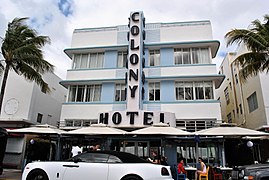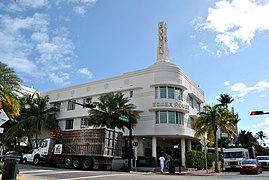Henry Hohauser
Henry Hohauser (May 27, 1895 in New York, New York – March 31, 1963 in Lawrence, New York[1]) was an architect in Miami Beach, Florida. He is known for his Art Deco architecture stylings, and is listed as a "Great Floridian"; in 1993, he was ranked as one of the 100 most influential people in South Florida history by The Miami Herald.[2]
Hohauser studied at the Pratt Institute in Brooklyn, New York before coming to Florida in 1932. Features of his work include symmetry on the front elevation, Art Deco stylings such as a ziggurat or stepped roofline, glass bricks, curved edges, and neon lighting.[3]
The PBS show American Experience called Hohauser and L. Murray Dixon the principal architects of Deco South Beach including "streamlined curves, jutting towers, window "eyebrows," and neon." Such buildings were less expensive and less ornamented than those by Carl Fisher, such as the and "seemed perfectly suited to a city created for sun, sand, and relaxation."[4] His work was low cost in order to serve the middle class tourists. He designed more than 300 homes, apartment buildings, hotels, stores, restaurants and theaters.[5] Many are now protected by the Miami Art Deco Preservation Society's efforts, particularly the late Barbara Baer Capitman.
Work in Miami Beach[]
- The Liberty Arm Hotel renamed (1939), 236 21st Street in Miami Beach.
- The Novick (1937), 610 Jefferson Avenue in Miami Beach.
- The Cardozo Hotel (1939), 1300 Ocean Drive in Miami Beach.
- The Colony (1935) 736 Ocean Drive. It was one of the early buildings erected during the Art Deco renaissance that revived Miami Beach after the great hurricane of September 1926 which had leveled the city in its infancy.
- The Century Hotel (1939) 140 Ocean Drive . in Miami beach.
- The Governor Hotel (1939) 435 21st Street, Miami Beach
- The Park Central Hotel (1937) 640 Ocean Drive, Miami Beach
- The Essex House Hotel (1938) 1001 Collins Avenue (Miami Beachwith porthole windows and a neon tower
- The Edison Hotel (1935) 960 Ocean Dr Miami Beach
- The Crescent (1941) 1420 Ocean Drive Miami beach
- The Davis (1941) The Scene, Formerly the Park Washington Resort, this is actually a collection of four hotels: the Davis, Taft, Belaire and Kenmore.
- (1936) 318 20th Street, Miami Beach FL renovated 2013 renamed Riviera Suites
- The Greystone Hotel (1939) 1920 Collins Avenue Miami Beach, renovated in 2018 renamed the Greystone Miami Beach
- (1939), 2000 Park Ave It includes a glass entryway and rounded corners
- , (1940) 1110 Drexel Ave. It was demolished in 1982
- Beth Jacob Social Hall and Congregation with at 301 and 311 Washington Avenue in Miami Beach. Listed on the National Register of Historic Places, it is now the Jewish Museum of Florida-FIU.
- The Parc Vendome (1936) 736 13th Street Miami Beach
- 1020 6th Street Apartments
- 5363 LaGorce Drive in Miami Beach
- 1610–1612 Pennsylvania Avenue, Miami Beach (the only apartment block of his to feature internal balconies)
Gallery[]

Cardozo (Henry Hohauser, 1939)

Colony (Henry Hohauser, 1935)

Park Central (Henry Hohauser, 1937)

Essex House (Henry Hohauser, 1938)

Edison (Henry Hohauser, 1935)
Other work[]
- Houses in the Far Rockaway Beach Bungalow Historic District (1921) in Far Rockaway, Queens in New York City.
References[]
- ^ "Henry Hohauser,The Art Deco Architect". My Belief. 5 October 2011. Retrieved 8 March 2018.
- ^ Retrieved from Jewish Museum of Florida
- ^ Neron Hotel World Digital Library
- ^ Special Features: Deco Miami Beach, Mr. Miami Beach, The American Experience
- ^ Retrieved from Jewish Museum of Florida
External links[]
- Architects from Florida
- Pratt Institute alumni
- 1895 births
- 1963 deaths
- People from Miami Beach, Florida




